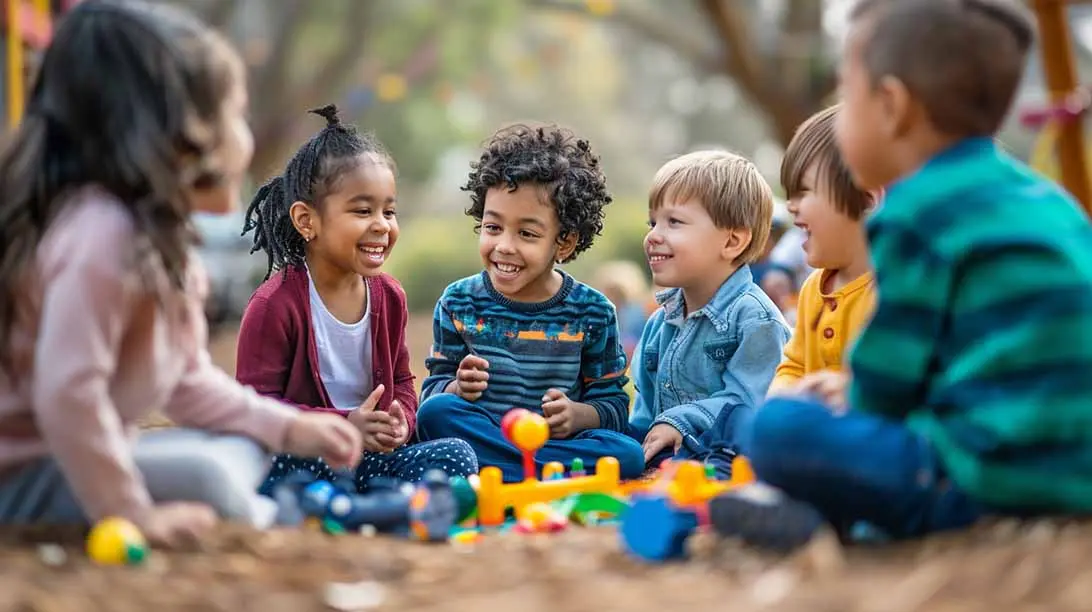Confronting young child social exclusion is critical for their well-being, yet it remains an elusive challenge for many parents and teachers. This article cuts to the heart of the issue, equipping you with ways to recognize exclusion signs in children, understand its profound effects, and access effective strategies to ensure every child feels included and supported.
Key Takeaways
- Social exclusion in young children can manifest in behavioral changes, emotional distress, and academic difficulties, with long-lasting impacts if not addressed.
- Development of social skills, healthy peer relationships, and inclusive play are essential components in combating social exclusion and fostering a better social environment for all children.
- Parental support through active listening, validation, and collaborative problem-solving, as well as communication with school staff and engagement in extracurricular activities, are critical in helping children overcome the challenges of social exclusion.
Recognizing Social Exclusion in Young Children
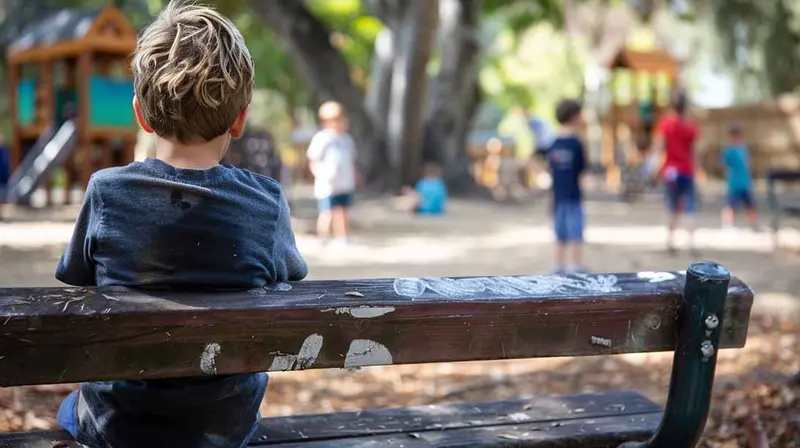
When whispers turn into isolation, and playground games become a source of anxiety, the signs of social exclusion begin to surface. Young children, unequipped to articulate their emotions, might manifest their distress through subtle yet significant behavioral changes. Exclusion can be as painful and damaging as physical bullying, and it’s not always visible to the untrained eye. Parents need to remain alert for signs that their child may be struggling to cope with peer rejection.
Whether it’s being left out of peer groups or being the target of rumors, understanding these cues is the first step in helping a child navigate the choppy waters of social dynamics. When most children are building friendships and learning social rules, those who face exclusion can feel lost, and without intervention, the impact can be long-lasting.
Behavioral Changes

The playground can be a battleground for some, where the armor of social skills isn’t enough to protect against the slings and arrows of peer interactions. Children who are shy, anxious, or exhibit aggressive behavior may find themselves on the fringes, unable to pierce the social veil that separates them from their peers. This temperament-driven exclusion is a double-edged sword; not only does it result in rejection, but it also deprives the child of opportunities to develop the very coping skills they need to integrate.
A sudden change in behavior, an unexpected drop in grades, or the emergence of behavioral problems are distress signals that merit attention and action.
Emotional Impact
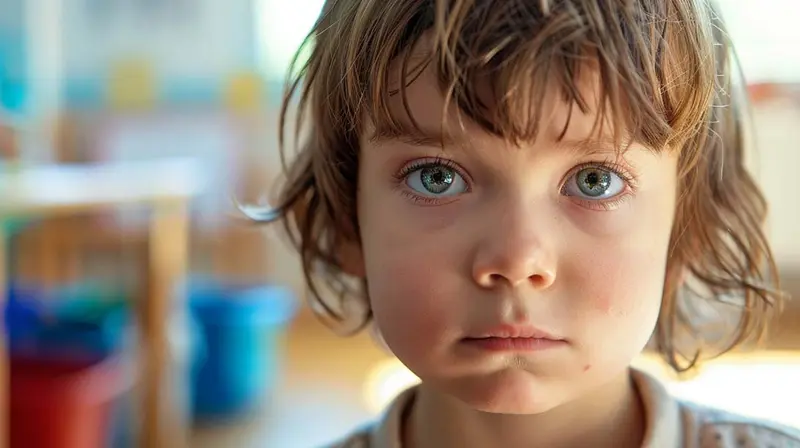
The emotional toll of social exclusion is a silent echo that resonates deep within a child’s psyche. Feelings of worthlessness and rejection can erode a child’s self-esteem, leaving them to grapple with anxiety and depression. These emotional burdens, although invisible, are as real and as heavy as physical ones. They can manifest in persistent sadness, a fear of future rejection, and a withdrawal from activities once enjoyed.
In such circumstances, interventions by mental health professionals become vital lifelines for young individuals navigating the challenging journey of social exclusion.
Academic Difficulties
A child’s academic life is not immune to the repercussions of social exclusion. When a child feels marginalized, their focus shifts away from learning, causing academic difficulties that can cast long shadows over their educational journey. The classroom should be a haven of knowledge and discovery, not a reminder of isolation.
A combined effort from parents and educators is essential to address these challenges and ensure that all children receive the necessary support to succeed, both socially and academically.
Developing Healthy Peer Relationships
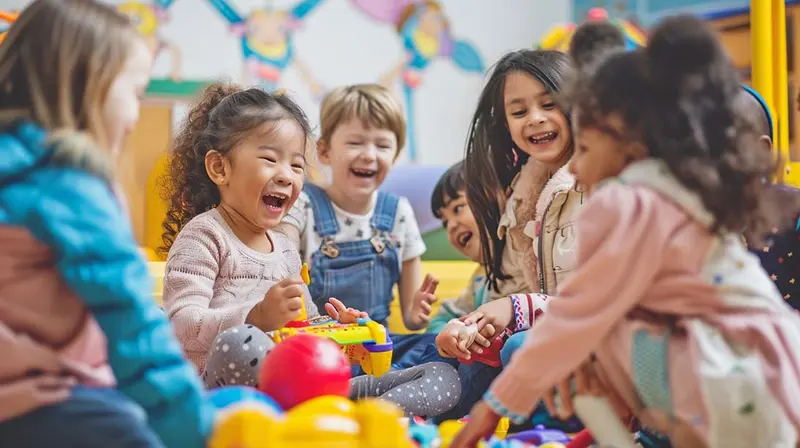
As the roots of a plant seek out water, so too should children reach out to nurture healthy friendships. The foundation of strong peer relationships is laid in the fertile soil of social skills, empathy, and inclusivity. When children learn to support other children facing exclusion, they not only help others but also bolster their own self-esteem and well-being.
Extracurricular activities can serve as vibrant social gardens, allowing children to cultivate new friendships based on shared interests, thus enhancing their comfort and connection with peers. Children who participate in these activities help create a resilient social network that can endure the strains of relational aggression and peer rejection.
Encouraging Social Skills
The tapestry of healthy peer relationships is threaded with the yarn of strong social skills. Empathy, the ability to walk in another’s shoes, can be developed through stories and activities that highlight the emotional landscapes of others. By encouraging our children to engage with a diverse array of peers, we foster a culture of respect and understanding, creating a buffer against the storms of social exclusion.
The integration of life skills programs in schools strengthens the fundamentals of positive interactions, providing students with the necessary tools to navigate complex peer groups and moral education. These social skills are the armor against interpersonal rejection, and with them, children can learn to be a good friend and develop friendships that are both meaningful and enduring.
Fostering Inclusive Play
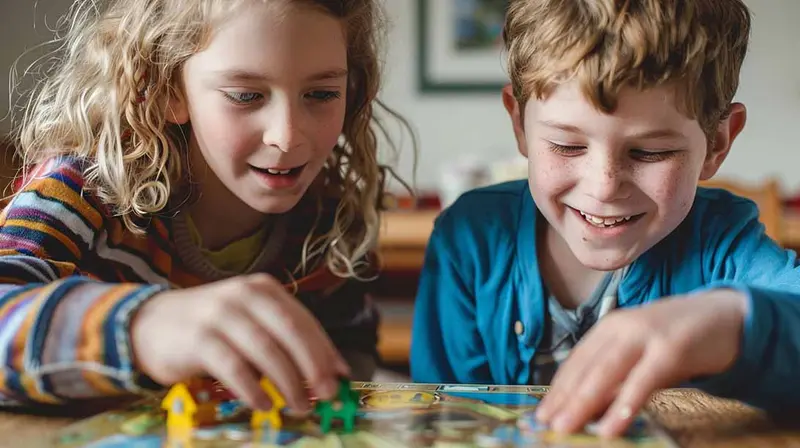
The language of play is universal, and when spoken with inclusivity, it can bridge gaps between children of all abilities and interests. Inclusive play environments are like kaleidoscopes, offering a spectrum of activities that cater to every child, ensuring that no one is left on the sidelines. From cooperative board games that teach teamwork to creative spaces that celebrate individual expression, these environments foster empathy and collaboration.
By providing options for both active and quiet play, children can choose activities that resonate with their personal comfort levels, promoting a sense of belonging and connection.
Parental Support and Involvement

A child feels safest when they are anchored by the unconditional support of their parents. In the choppy waters of social exclusion, it’s the parents who must listen with empathy, offering patience and encouragement without the instinct to take over the helm. It’s through this active involvement that children learn to navigate their child’s feelings of being shunned, gaining the confidence to steer their own course and helping the child cope with social exclusion.
Parents play a quintessential role in guiding their children away from victim thinking and towards empowerment, emphasizing their child’s control over their response to exclusion. In severe distress situations, like suicidal thoughts, urgent professional intervention is absolutely essential.
Active Listening and Validation
The art of active listening is a parent’s most valuable tool in the quest to support a child facing exclusion. Validation comes from acknowledging the child’s feelings with understanding and without rushing to offer solutions. When children are hesitant to talk, it’s the parents’ role to provide a safe space and the assurance that their voice will be heard when they’re ready to share.
By discussing the realities of social exclusion openly, parents can recognize the prevalence of this issue while validating their child’s unique experience.
Collaborative Problem-Solving
Transitioning from exclusion to inclusion is best achieved via collaborative problem-solving. By involving children in the search for solutions, parents empower them to face challenges head-on. This process not only addresses current issues but also equips children with the coping strategies and moral reasoning to handle future adversities.
Communication with School Staff
A strong alliance between parents and school staff forms a formidable defense against the impacts of social exclusion. Open communication with teachers and school psychologists can shed light on the underlying reasons for a child’s isolation and spark collaborative strategies to promote inclusion.
By involving school personnel, parents ensure that their child is supported by a community that values every student’s well-being.
Extracurricular Activities and Friendships Outside School

Beyond the classroom walls, a world of extracurricular activities beckons, offering a stage for children to showcase their talents and passions. The guidance provided by teachers and mentors in these settings is invaluable, as it fosters relationships that strongly contribute to a child’s social and emotional development. Such activities not only help children recover a sense of normalcy after disruptions, such as pandemics, but also contribute to their identity and self-worth.
Moreover, friendships formed outside the confines of school can serve as a sanctuary from the tribulations of peer group dynamics, offering solace and a fresh perspective on everyday life.
Building Self-Confidence

The building blocks of self-confidence are found in the activities that children naturally gravitate towards. Some examples include:
- Art classes, where children can express themselves creatively
- Science clubs, where children can explore and discover new things
- Sports teams, where children can develop physical skills and teamwork
- Music lessons, where children can learn to play an instrument or sing
- Drama clubs, where children can act and perform
These environments allow younger children to shine and foster a robust sense of self-worth.
Discovering and nurturing hidden talents can dramatically lift a child’s confidence, providing a wellspring of resilience to draw from in times of social exclusion. Encouraging children to focus on controllable, positive qualities can offer stability and a sense of empowerment that buffers against the impact of being ostracized.
Diversifying Social Circles
The social tapestry of a child’s life is enriched by the threads of diverse friendships woven through various extracurricular activities. As children engage with peers from different social groups, they expand their social circles, creating a multifaceted network of support that can soften the blow of exclusion at school.
This diversity of interactions serves as a protective layer, shielding children from the adverse effects of peer rejection and fostering a sense of belonging across multiple domains.
Professional Support and Intervention
Sometimes, the weight of social exclusion requires the steady hand of a professional to lift. Adolescents, in particular, are vulnerable to the sting of peer rejection, and the mental health issues that can ensue call for expert intervention.
School psychologists, counselors, and administrators are the architects of a supportive school environment, crafting interventions that address the unique needs of each student.
Seeking Counseling
Counseling provides much-needed hope for those struggling with the turbulent impact of social exclusion. It provides a safe haven where children can process their emotions and develop the coping skills necessary for resilience. Counselors offer strategies for parents and children alike, aiding in the journey from exclusion to empowerment.
When the involvement of an outside counselor or trusted adult is sought, it brings an objective perspective that can be crucial for the child’s emotional recovery.
School-Based Interventions
The school setting is a critical battleground in the fight against social exclusion. School psychologists and counselors lead the charge, providing a shoulder for students to lean on as they navigate their social world. These dedicated professionals strive to create a school environment that champions inclusion and diversity, utilizing strategies like self-advocacy and stress reduction to enhance a child’s social skills.
When school staff communicate directly with each other, they form a united front, ensuring that no child slips through the cracks of social exclusion.
Summary
In the vibrant tapestry of a child’s life, social exclusion is an unwelcome stain that can be difficult to remove. Yet, with the right knowledge, strategies, and support, parents can help their children to navigate this challenge and emerge stronger. By fostering healthy peer relationships, offering unconditional parental support, engaging in extracurricular activities, and seeking professional intervention when needed, we can create a world where every child feels included, valued, and empowered.
Frequently Asked Questions
What are the signs that my child might be experiencing social exclusion?
If your child is refusing to go to school, experiencing loss of appetite, sudden changes in appearance, becoming non-communicative, loss of interest in activities, or a rapid drop in grades, these could be signs of social exclusion. It's important to address these changes promptly to support your child's well-being.
How can I help my child develop better social skills to prevent exclusion?
Help your child develop better social skills by encouraging empathy and respect, engaging them in diverse peer interactions, and enrolling them in school-based life skills programs. This can prevent exclusion and promote healthy relationships.
What role can extracurricular activities play in combating social exclusion?
Extracurricular activities can help combat social exclusion by building self-confidence, fostering new friendships, and boosting a sense of self-worth in children. This can act as a buffer against exclusion.
Should I intervene if my child is being socially excluded, or should I let them handle it on their own?
You should empower your child to devise their own solutions while maintaining open communication with school staff and seeking professional help if necessary. It's important to listen and validate your child's feelings, but also encourage them to handle the situation.
When is it appropriate to seek counseling for my child regarding social exclusion?
It is appropriate to seek counseling for your child regarding social exclusion when they show persistent distress or behavioral changes as a result. Counseling can provide strategies for coping and building resilience.
